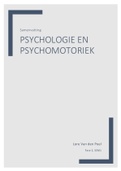Summary
Volledige samenvatting Psychologie en Psychomotoriek
- Course
- Institution
Dit document is een samenvatting van het vak 'Psychologie en Psychomotoriek' uit fase 2 van de richting Logopedie en Audiologie van de Thomas More Hogeschool in Antwerpen. Dit vak wordt gegeven door meneer Roelands (psychologie) en mevrouw Bolckmans (schrijfmotoriek). Het document bevat ook een zel...
[Show more]



